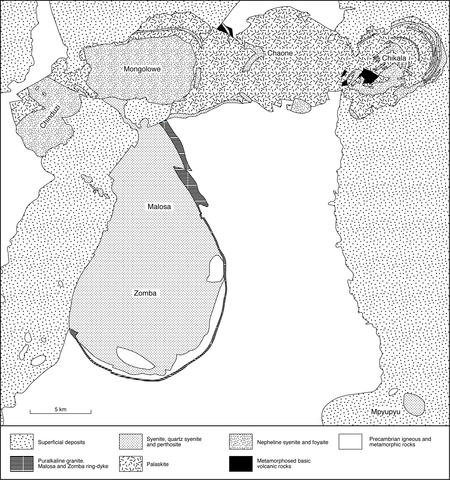stripes
The Zomba-Malosa complex is the largest intrusion in the northern part of the Chilwa province. It is pear-shaped in plan and extends southwards for 24 km from the Mongolowe intrusion (No. 103-00-027), with which it is in contact; the maximum width is 13 km. The southern half of the complex is generally referred to as Zomba Mountain and the northern part as Malosa, the two being separated by the deeply incised Domasi Valley. The massif rises spectacularly on all but the northern sides as precipitous scarps with the southern half forming a high plateau, which is accessible by road. The main peaks rise to over 2000 m, some 1300 m above the surrounding plains. The geomorphology of the massif has been described by Bloomfield and Young (1961). The western margin is cut by the main northeast-trending rift valley fault (Bloomfield, 1965) but elsewhere the outer contacts cut Precambrian paragneisses and charnockitic granulites of the Mozambique Belt. The whole complex is made of granites and quartz syenites and Bloomfield (1965a) recognised at the southern end a central plug, an inner ring and an outer ring. The outer ring is, however, the only clearly mappable feature, forming a peripheral granite ring-dyke some 100 m wide that can be followed for about 25 km along the southern and eastern boundaries; it is separated from the main complex over much of its length by a screen of basement gneiss. A large roof pendant or xenolith of basement gneisses lies within the most southerly part of the intrusion. The inner ring on Zomba Mountain has a gradational boundary with the central plug and cannot be clearly defined. Although a number of varieties of syenite and granite can be distinguished in the field contacts throughout the intrusion are generally gradational. Dykes of microgranite, microsyenite and pegmatite are common, particularly in the northern part of the complex. The central plug of Zomba Mountain is a coarse syenite of perthite, generally a little quartz, aegirine-augite zoned to aegirine, which may be mantled by amphibole, fresh or altered fayalite, minor biotite and accessories. The rocks of the inner ring are similar except for the presence of zoned alkali feldspar phenocrysts and poikilitic amphibole; pyrochlore and chevkinite are rare accessory minerals. Most of the rocks of Malosa Mountain are similar with greater or lesser amounts of quartz but some types contain aegirine, an arfvedsonitic amphibole and are free of fayalite. The granites are generally coarser rocks of tabular to sub-tabular alkali feldspar up to 1 cm in length, interstitial quartz, hedenbergite to aegirine, sodic amphibole, and in some rocks fayalite or its alteration products. Accessory minerals commonly include zircon and pyrochlore with less widespread fluorite, aenigmatite and astrophyllite. Dyke rocks include alkali feldspar-quartz porphyries and aegirine-aenigmatite microgranite. Woolley and Jones (1992) have described the mafic mineralogy of the complex and demonstrated that the pyroxenes define distinct ‘Zomba’ and ‘Malosa’ trends in terms of diopside-hedenbergite-aegirine, that the amphiboles include an exceptional range of species from calcic to alkali types, and that the micas also reveal some chemical diversity. Chevkinite from Zomba has been described by Platt et al. (1987). Rock analyses will be found in Bloomfield (1965) and Woolley and Jones (1987).
BLOOMFIELD, K. 1965a. The geology of the Zomba area. Bulletin, Geological Survey of Malawi, 16: 1-193.BLOOMFIELD, K. and YOUNG, A. 1961. The geology and geomorphology of Zomba Mountain. Nyasaland Journal, 14: 54-80.EBY, G.N., RODEN-TICE, M., KRUEGER, H.L., EWING, W., FAXON, E.H. and WOOLLEY, A.R. 1995. Geochronology and cooling history of the northern part of the Chilwa Alkaline Province, Malawi. Journal of African Earth Sciences, 20: 275-88.GEOLOGICAL MAP OF MALAWI (compiled by K. Bloomfield), 1966. 1:1,000,000. Geological Survey of Malawi, Zomba.PLATT, R.G., WALL, F., WILLIAMS, C.T. and WOOLLEY, A.R. 1987. Zirconolite, chevkinite and other rare earth minerals from nepheline syenites and peralkaline granites and syenites of the Chilwa Alkaline Province, Malawi. Mineralogical Magazine, 51: 253-63.WOOLLEY, A.R. and JONES, G.C. 1987. The petrochemistry of the northern part of the Chilwa alkaline province, Malawi. In J.G. Fitton and B.G.J. Upton (eds), Alkaline igneous rocks. 335-55. Geological Society of London, Special Publication 30.WOOLLEY, A.R. and JONES, G.C. 1992. The alkaline/peralkaline syenite-granite complex of Zomba-Malosa, Malawi: mafic mineralogy and genesis. Journal of African Earth Sciences, 14: 1-12.

